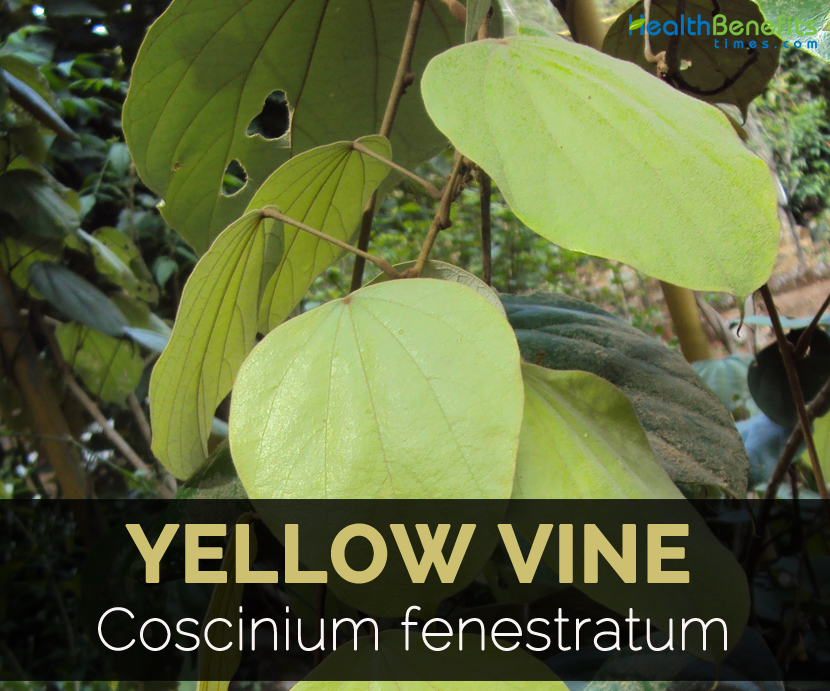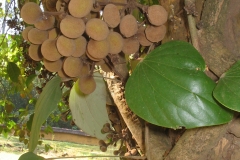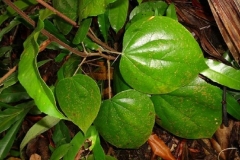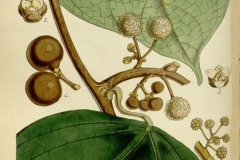Coscinium fenestratum is the source of crucial Ayurvedic raw drug daruharidra dating back to several centuries. Stem has been used for long in South India and Sri Lanka as a yellow dye and bitter tonic. It has found its way to Europe as Tree Turmeric or False Claumba. It is a large, dioecious and woody climber that belongs to Menispermaceae family. It prefers humus rich soil with good drainage and areas with more than 2000 mm rainfall having annual mean temperature 27 degree Celsius. The liana requires 15 years to reach its reproductive stage.
Its habitat spans South Asia and parts of Southeast Asia from India to Indonesia. It thrives in a tropical climate and prefers mixed as well as dense evergreen forest having fertile soil and high moisture. It is found in Asian countries such as Malaysia, India, Myanmar, Vietnam, Thailand, Singapore and Sri Lanka. It requires long seed germination times and requires 14 to 15 years to mature and flower. Use the stem decoction internally for the cases of bites from monkeys, Brahmin lizards, snakes and geckos. Root bark is used to dress wounds, cutaneous leishmaniasis and ulcers. Take the mixture of bark and honey internally to treat jaundice.
Distribution
The plant is endemic to India and also reported in Vietnam. The species is restricted within India to the Western Ghats of Karnataka (Udupi, Coorg, Dakshin and Uttar Kannada districts), Kerala (Thiruvananthapuram, Thrissur, Wynaad, Idukki and Palakkad) and Tamil Nadu (Tirunelveli, Kanyakumari and Nilgiri districts) up to an altitude of 1000 m. The species is limited to semi-evergreen and wet evergreen forests.
Traditional uses
- In traditional Siddha and Ayurvedic system of medicine, the plant is used to treat diabetes mellitus.
- Root powder and decoction is used to treat flatulence, indigestion, fever and liver diseases.
- Stem extract or bark decoction is used for intermittent fevers.
- Roots are bitter tonic, used to dress wound and also treat ulcers.
- Stem extract is used in snake bites.
- In coastal Karnataka, India, plant is combined with other medicinal plants for treating herpes.
- It is used for ulcers, wounds, burns, jaundice, abdominal disorders, skin diseases, fever, diabetes and general debility.
- Tincture, infusion and concentrated liquor are used to wash wound and skin rashes.
- Root bark is used to dress wounds and ulcers.
- It is used for treating eye diseases and influenza.
- Boil the pieces and bath with this water to provide relief from body pain.
- It is helpful for excessive bleeding during menstruation and bleeding piles.
- Apply the paste of Coscinium and turmeric for snakebite poisoning.
- Apply Coscinium powder mixed with ghee to speed up healing of ulcers.
- In Chhattisgarh, the traditional healers use the bark for treatments.
- Internally take the combination of bark and honey to cure jaundice.
- Use the bark for treating leucorrhoea and gynaecological troubles.
- In Peninsular Malaysia, the decoction is applied after childbirth.
- For stomachache and colic, crush the roots or old parts and boil.
- Use the plant to treat fractures.
- Stem is used for skin diseases, ulcers, wounds, cough, tastelessness, abdominal disorders, liver disorders, intrinsic haemorrhage, snake bite, diabetes, general debility and fever.
- Stem extract is used for snake bites.
- Drink the decoction of fresh bark (by boiling bark in water) in an empty stomach in the morning regularly.
Other facts
It has the generation span of 25 years.
References:
https://echarak.in/echarak/templates/Coscinium%20fenestratum%20(Gaertn.)%20Colebr..pdf
https://scialert.net/fulltextmobile/?doi=jps.2008.133.145
http://www.bsienvis.nic.in/CITES/Coscinium%20fenestratum.pdf
https://scialert.net/fulltextmobile/?doi=pharmacologia.2012.679.682
Comments
comments
| Yellow Vine Quick Facts | |
|---|---|
| Name: | Yellow Vine |
| Scientific Name: | Coscinium fenestratum |
| Origin | South Asia and Mainland Southeast Asia |
| Colors | Brown, orange or yellow |
| Shapes | Drupe, globose or subglobose, 2.6 – 3 cm across |



